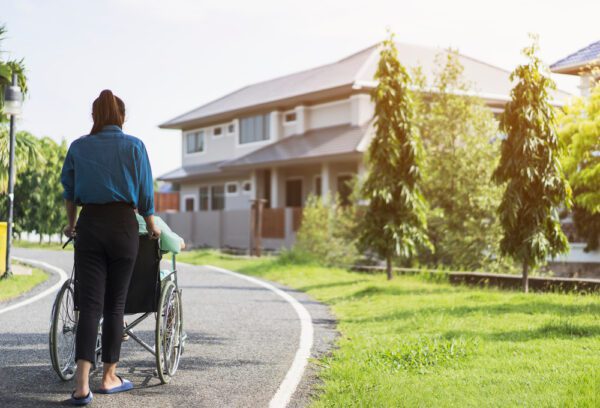
10 October 2022
Eviction when subletting healthcare-related property: take care!
There are various players involved in the subletting of healthcare-related property.
Consider the housing corporations or the owner/investor in the role of main lessor. Also there are the healthcare organisation in the role of main lessee/ sublessor and the actual occupants as sublessees. What happens if the housing corporation wishes to terminate the lease with the healthcare organisation? Do the sublessees have to leave? This article explains the situation regarding eviction when subletting healthcare-related property. Attorney Marie-Christine Veltkamp-van Paassen of GMW Advocaten clarifies the situation.
The main lease
The main lease is characterised by its commercial nature. After all, the healthcare organisation does not lease the property because it is going to be based there itself. It operates the property in order to achieve its organisation’s goal of providing healthcare to people who have healthcare needs. In principle, a commercial rental regime therefore applies to this relationship, in this case the rental regime of Article 7:230a ff. of the Dutch Civil Code (Burgerlijk Wetboek). This means that the lease has almost no legal protection for the lessees. It is mainly governed by the contractual provisions.
There is, however, legal protection against eviction. If the lessor has given notice of eviction towards the end of the lease, the lessee may request the sub-district court to extend the eviction period if it can clearly show that its interests in continuing to use the property outweigh the lessor’s interests in eviction. It is possible to extend the eviction period up to three times with a maximum of one year each time.
The sublease
In most cases, the sublease is distinguished by a relationship in which healthcare predominates. The housing is used for healthcare and is made available only for healthcare purposes. In the event that the main lease ends and the healthcare organisation has to vacate the healthcare-related property, the actual occupant has no rent protection. The main lessor can force the occupant to leave. At most, the occupant is entitled to compensation from the healthcare organisation if there is a breach of contract. But the occupant cannot continue to reside at the healthcare property.
However, if the healthcare relationship is not or no longer predominant in the sublease and/or has lost its meaning, the sublease will focus on the residence aspect. In that case, the occupant enjoys rent protection. This rent protection then extends to the main lease. The lease transforms into a regime with rental protection because the occupant receives rent protection in the sublease. In that case, the sublease can only be terminated if there are legal grounds for termination, such as bad tenancy or urgent own use.
Extension of the eviction period
The Subdistrict Court of Arnhem (ECLI:NL:RBGEL:2019:3004) ruled in 2019 on a case in which a housing association had terminated the lease with a healthcare organisation. The healthcare organisation ran into problems as a result. In the short term, it had proved to be impossible to relocate the 30 residents in need of care to whom it was subleasing. The housing corporation also argued that its interest in the eviction should outweigh the interest of the healthcare organisation, because the residents were causing a nuisance. The Subdistrict Court ignored this, because the nature of the lease meant that the healthcare organisation could not always prevent a certain degree of nuisance.
In addition, the severity of the nuisance had not been sufficiently demonstrated. The Subdistrict Court extended the eviction period. This meant that the healthcare organisation did not have to evacuate. And the occupants could continue to live in ‘their home’ for a while.
Monthly tip
Once the main lease of healthcare-related property has been validly terminated, the healthcare organisation has little choice but to apply for an extension of the eviction period. Unfortunately, this does not prevent the forced departure: at best, it postpones it.
It is therefore important for a healthcare organisation to limit the legal validity of the termination of the lease. This can be done by making agreements in the main lease about the circumstances under which the housing association or owner/investor may terminate the lease. In doing so, a connection can be sought with rental regimes that provide for rental protection. For example, the lease may then stipulate that termination is only possible in the case of urgent own use or bad tenancy that justifies the termination of the lease.
Would you like more information?
Would you like advice on eviction in the case of subletting? Or do you have another question related to real estate law? Then please do not hesitate to contact me.
31 January 2024
Robot lawyer
A ‘robot lawyer’ has been made available on the market in America. This is an app with legal information that would make using a lawyer unnecessary. ‘Fight corporations’, ‘find hidden money’, ‘beat bureaucracy’. This is what the robot can and will do. ‘Sue everybody,’ is the urgent advice.
Read more
24 January 2024
Contracting work
A building contract exists when one party, the contractor, undertakes to the other party, the client, to deliver work for payment of a sum of money.
Read more
6 December 2023
Didam judgment: contracts void or voidable?
In the context of administrative law, the Division has previously ruled that public bodies are required by the principle of equal opportunity or equality to provide interested parties with scope to compete in the event of scarcity.
Read more
